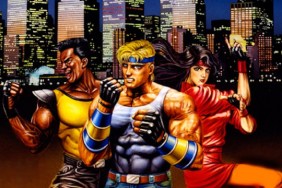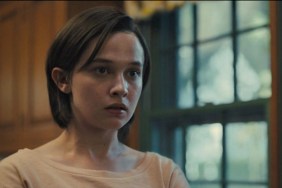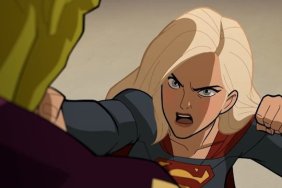We’ve also updated out gallery with three new character posters that you can check out large versions of by clicking here.
Although The Wolverine takes place after all previous X-Men entries, the film’s opening scene flashes back to 1945 where Logan is being held at the bottom of a stone well at a prison camp in Nagasaki. Although he can climb out with his (still bone) claws, Logan hears the ominous sound of planes in the distance and realizes that the US is about to drop an atomic bomb.
Attempting to save the life of a Shingen Yashida (as seen in the trailer), Logan dives into the well and shields the man from the blast. Although Logan’s flesh is ripped right from his body, his healing factor kicks in rapidly as the blast subsides.
Logan wakes up many years later. He’s in bed with Famke Janssen’s Jean Grey. He’s promising her that he’ll never hurt anything ever again but, suddenly, he looks down to see that his (now adamantium) claws are sticking through her chest.
Logan awakes again with a start. It was just a dream, but Jean is gone. We’ve moved past the events of X-Men: The Last Stand and Logan is now living like a hermit in the dense wilderness of North Dakota. He has a huge, bushy beard and, as he stands and wanders the forest, he comes across a bear, bleeding to death and in a great deal of pain. Although he can’t stand to break the vow, he also can’t let the creature suffer and, killing it mercifully, heads into town to seek vengeance against the hunter that illegally left it to die.
Logan approaches the hunter he knows is responsible, but as he fights with the guy in a bar, he’s approached by Rila Fukushima’s Yukio. She calls him The Wolverine, but he tells her that that’s not who he is anymore. She wants him to follow her and he reluctantly agrees, quickly learning that whatever is needed of him is happening in Japan.
Another, shorter, scene had Logan — now without the use of his regenerative powers — battling men in and around a bullet train shooting its way through a Japanese metropolis.
Through it all, Mangold just grins, clearly anxious to show off his final film. Seated opposite a table littered with Wolverine comics (everything from the Frank Miller / Chris Claremont miniseries upon which the film is largely based to more recent fare like Brian K. Vaughan’s “Logan” miniseries and Mark Millar’s recent run), the man behind features like Walk the Line and 3:10 to Yuma spoke a bit about his first foray into comic book adaptations.
Q: How does the film as it now stands compare to the version that was in your head when you first started on the project?
James Mangold: I think this is a unique thing in the sense that, from when I came on, the process has been one of moving steadily towards becoming what I came on and presented. There are several advantages to this project. I think you get most of them. It’s kind of a subset. It kind of exists connected, both through casting and just in kind of lineage, to the other movies. But it’s also its own subset. It also exists in its own world. That gave me a certain amount of freedom… When I first came on the movie I started looking at the existing materials that I was most interested in making a movie about and that I felt could coexist with the flagship plot movements of the Claremont/Miller saga as well as the pieces that I was inevitably going to inherit from other films. There was this idea of the struggle of being immortal and the struggle of being forever and the struggle of knowing you will lose everyone you love. The first thing I wrote on the back of the script when Fox sent it to me was, “everyone I love will die.” That’s what I kind of figured the movie to be about. That has always interested me. When I was a kid — until they made it already — I wanted to make a film of “Bicentennial Man,” which was really about the same thing. I can’t say the movie ended up being about that, but the story is about the loneliness of a god. Of someone who lasts forever and must say goodbye to anyone they’ve ever loved, because eternity is eternity after all. To add to that is Logan’s own curse in a way that brings or signals the downfall of everyone he seems to love. It was an assumption I made when I came in the first time to talk about the project that this movie took place after everything. It was an assumption I made just kind of looking at the comic and the materials that existed, but it wasn’t one they had made already. The idea was really useful that he had lost everyone. That no one was left. I wouldn’t have the burden of having to juggle balls of other X-Men that might be around. It’s just all gone. You’re coming in in a place where he is suffering from the loss of his compatriots. He’s suffering from the loss of his mentor and the loss of his love. There’s really no hope toward replacing any of it. That seemed like a really thematically strong place to start a story, especially one that we’re going to take to another place and another land.
Q: There were clearly elements outside your control that happened in Japan during development. Was there ever a moment where you thought that this movie might just not happen?
Mangold: Yes, but they weren’t in relation to that. I came on after that. In a way, to me, the delicacy and the intensity of what happened in Japan added a kind of challenge that the material actually be worthy and be serious enough. That it was taking into account what the country had been through and healed from was something that I wanted. The fact that the world had witnessed that culture surviving something as apocalyptic as what they had gone through, was a source of incredible inspiration, admiration and respect for the culture. That meant the movie, if done right, could actually address — if not implicitly — that culture. In a way, part of what you saw in the opening of the picture using Nagasaki as a different traumatic event was a way of talking about the resilience. It won’t be the last time we’re back in that place in the film where that happened. We visit the footprint of that bomb and what it tries to speak to is the resilience of this culture. Their incredible strength, no matter what is thrown at them. All these things are kind of in the same family. They’ve been dealt more nuclear blows than any culture or land mass in the world. Those things can be limiting but, thankfully, there was a little bit of time and if you respect the events and respect the real life tragedy, you can drive it to address it in some mature way.

Q: What was the biggest thing you have learned in the editing room on this one? Was there the chance to go out and do reshoots?
Mangold: For action scenes, there’s a few inserts I’m going to pick up. But no. If anything, I discovered that there’s things we didn’t need. The interesting thing is that there are many scenes where I wanted to make sure that people understood aspects of the culture or the world or the plot. More and more, it dawned on me that we had succeeded. I’m not saying it’s perfect, but I found that since we had succeeded on the one mission, we didn’t need the other. We’re making a western and there’s not a lot of talking. He probably said seven things in the 20 minutes you saw. That he talks less was really critical to me. Using the example of samurai films or “Josey Wales” or anything else you want to talk about that I’ve kind of raised before. The idea is that, first and foremost, we’re not explaining everything all the time to the degree that we’ve been able to cut some stuff loose from the film. It’s been over-attentiveness to what audiences actually get and that they understand. Movies, for my taste, tend to over-explain. It’s kind of defensive, partly because of the internet. There’s so many people poking holes in things, you get in this arms race trying to protect yourself from some of the holes that have been poked in it. The truth is, sometimes every explanation you offer offers three new things for someone to pick at. In a way, you’re almost better off going, “It’s Chinatown.” Do I know everything about water and power in Los Angeles at that time? No, but I know enough to follow the movie and have it make sense to me. That’s always the balance you’re looking for.
Q: This is Hugh’s sixth time playing Wolverine. How important was it to introduce an element like mortality that we haven’t seen the character deal with on-screen before?
Mangold: That was one of the things that seemed like common sense to me. When you have him on his own and are not doing an origin story, he’s impervious to everything except for some elaborate forms of death that people can think up. The reality is that you’re robbing yourself of a kind of simple stakes but, also, the question in total asks a lot of questions about mortality and about what it is we’re after when we’re trying to be forever. About love. About suicide. About calamity. About love lasting beyond the grave. A lot of questions that, to me, are interesting. But let’s take “First Class” off the table for a second because there isn’t much to talk about besides him making a great cameo in it. In the three existing “X-Men” movies, he’s part of a team. He’s on a task force. Therefore, the form of the films and what you see of him plays out in relation to a kind of round robin of the action in these various places. In the one existing solo “Wolverine” film, it’s an origin story and has devoted so much of its energy to that and also to other mutants. It never really got a chance — I guess really the answer is, to me, is that I thought it was wide open. One of the reasons I took it was that, despite the fact that there has been a lot of movies, there was this big softball down the center. You have the right actor. You have the world and an audience that’s going to come see this thing. You have a chance to do something that feels like what everyone in the world — including me — wants to see and hasn’t been done. It’s a chance to focus on him and not have to tell the story of how he became him. We can tell a story just about him and allow him to explore his rage. To explore his methods of fighting and conflict. Mystery solving. Love relationships. All of it without it having to be on the head of a pin and cutting away because you have to show nine other things. Also, if there was anything I thought I pulled the reins in for myself from, it was just that I felt his abilities had started to expand to the point where I felt he was losing something. I wanted to return him to the confines of his own abilities. He can’t jump up and pull down a helicopter in this film. That’s just, for me, I like the level that he’s not Spider-Man and not Superman. He has claws and he has strength and he’s tremendously impervious, though not all throughout this film. It’s a little more about anger and determination and being a kind of Frankenstein monster of both nature and man. The kind of psychic wounds you carry through life with that. It’s more about that than just doing cool s–t you haven’t seen before. With some of the other movies I was tweeting about, I was trying to return it to more a kind of “French Connection” or “Bourne”-style action in which you feel like it’s occurring in this world and it isn’t so fantastical that you don’t believe this character exists in this world. One of the things, particularly in the Marvel Universe, that I felt was so great growing up and reading it was that it felt like it took place in my world. It didn’t feel like it was some kind of Disneyland world. That was something that I really wanted to get in this. It’s very much an adult world.
Q: This is being released in 3D. What kind of 3D are you a fan of?
Mangold: I like adding depth. I’m not into anything that makes you aware you’re watching it, meaning the s–t that makes you go, “Whoa!” and turn to someone. I don’t want you to become aware that the technology is asserting itself. I feel the same way about surround sound, by the way. I don’t like watching a baseball movie and hearing people yelling behind me. I turn around. There’s a level of immersion that is perfect and there’s a level that, for my taste, starts to actually exceed what the screen can provide. At that point, you’re kind of overexceeding yourself. I wanted the movie to be real so I wanted the level of 3D that would make things look real but not reach the kind of gimmicky 3D that reaches out and grabs your nose.

Q: Do you go back and re-watch all these movies you listed and make note of specific scenes you want to capture tonally?
Mangold: It’s more just that I’ve been watching these movies since I was so young that they live in me. I think you get in trouble when you actually start watching movies verbatim and trying to break out the structure and literally mimic it. It has never been natural for me to do that. I haven’t done it in other pictures. What you learn is about tone and about how they made decisions, but you try not to kind of — because nothing’s ever the same. When you try to make a dish like that restaurant made it, you’re always in trouble. But if you’re like, “Wow, that’s opened up thai cooking for me!” that’s useful. There’s a level where the themes of a film are very relevant to me and also the idea of finding out how relevant one genre is to another. I think that westerns and samurai films and superhero films have a lot in common. It’s just that the scale of the visuals in tentpole films can sometimes overwhelm the drama. What can sometimes overwhelm the western is that the technological limitations of the era kind of restrict the ability for someone to just go crazy with CG. You’re forced to actually do your job and make a story that people care about and action that seems real because there’s a point where you just can’t go to 12 on the volume knob. There is no 12. It’s still steamtrains and six-shooters and, at some point, the audience is going to have just buy without being visually and aurally overwhelmed.
Q: What has been the trickiest sequence to get perfect in the editing?
Mangold: The trick of your question is that it’s innately looking for me to say that something’s a problem so that I don’t know how to answer it without digging a ditch for myself that I won’t be climbing out of for the next three months. The reality is that nothing has been innately a problem. It’s moreso the reality of making a movie with a huge amount of visual effects that you work your way through sequences in chronological order, particularly the order you shot. For certain reels of the film, visual effects are just starting to come in. There’s a lot of discovery and adjustment that goes on because suddenly there’s things that have been greenscreen and just a figure with dots on them that is suddenly relating to your hero. We’re always working on ways to improve it. What I think is grand about this movie, and I think Fox deserves a lot of credit, is that it’s a picture in which they got together people they trust to make the film, some of whom worked with them before. Then they let us make the movie. We kept the film on budget and we finished the film on time. To their credit, we had a lot of autonomy in making the movie. Its been a very even, honest process working on the film and making it. It’s one of those times also where the film that I pitched to them and the film that Hugh wanted it to be is the film we’re making. There’s no moment of everyone going, “Oh my god. I’m supershocked and horrified by the picture you made!” They’ve seen it. They like it. It’s what we told them it would be and I think they feel like it’s what audiences are expecting to some degree. As processes go, it’s actually really smooth. And you actually get to work on the movie instead of balancing stuff.
Q: Were there any X-Men characters or properties you hide to shy away from because it might be used later on?
Mangold: The great thing about going to Japan and being after everything is that there’s not a lot to trample on. Because I was really well along before the new X-Men film got going and they knew what it was going to be, I was pretty out the door. As it so happens, the new picture operates in its own way autonomously. I didn’t have much of a domino effect on anything else, which was the joy of it. Other than I wanted him to not wear a wig anymore. I wanted to so something with his real hair. To me, it was all about — endlessly my evangelism on the movie was all about trying to make it real. Hugh’s body is as real and ripped as it could be. His hair is his real hair. We were trying to find a way that the claws and his physicality were something that could happen in the universe you live in as opposed to it being the result of inordinate numbers of cables and effects.
Q: Can you talk about that Silver Samurai design? Is it as heavy as it looks for the actor to wear?
Mangold: It’s a bitch. The whole thing will be, I think, a real technical Marvel in the movie. It’s going to look pretty beautiful. Francois and the designers working with him came up with a really beautiful design. But I can’t probably say more without revealing too much.
The Wolverine arrives in theaters July 26.



